Arne Slot’s tactical approach has garnered significant attention, especially with his rumored link to Liverpool. Known for his fluid, high-pressing football, Slot’s philosophy emphasizes quick transitions, ball control, and intelligent pressing schemes. This tactical analysis dives deep into how Slot’s strategies could align with Liverpool’s style and where he might bring fresh perspectives. By breaking down his formations, pressing systems, and attacking play, we’ll explore what makes Arne Slot a tactician worth watching and how his methods might impact a team like Liverpool.
Build-up
Low Build-up
Arne Slot sets his team up in a 1-4-2-2-2 formation in the low build-up. He uses two dropping strikers/number-tens and looks to attract opposition players to open up the space in behind for the wingers to exploit.
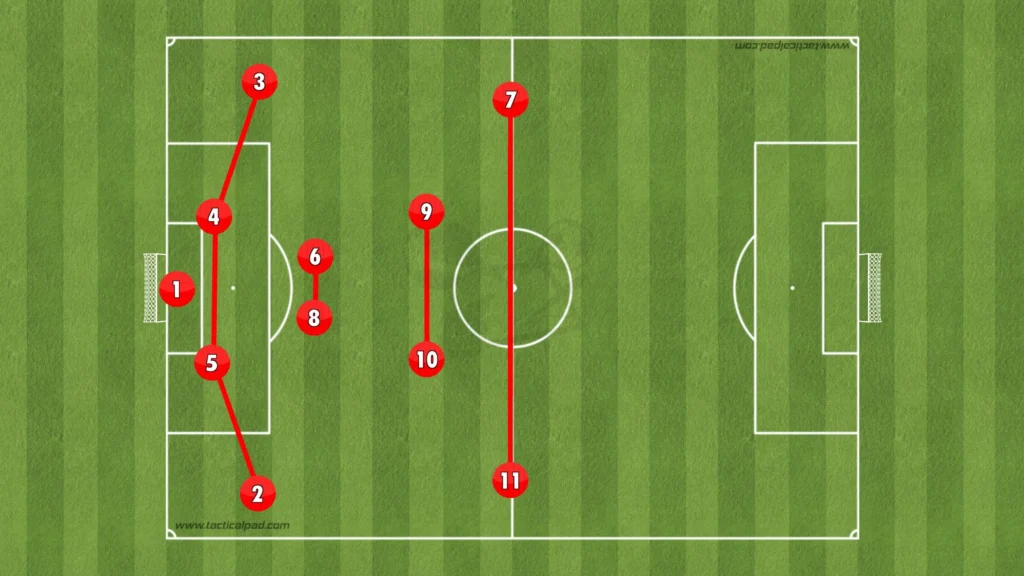
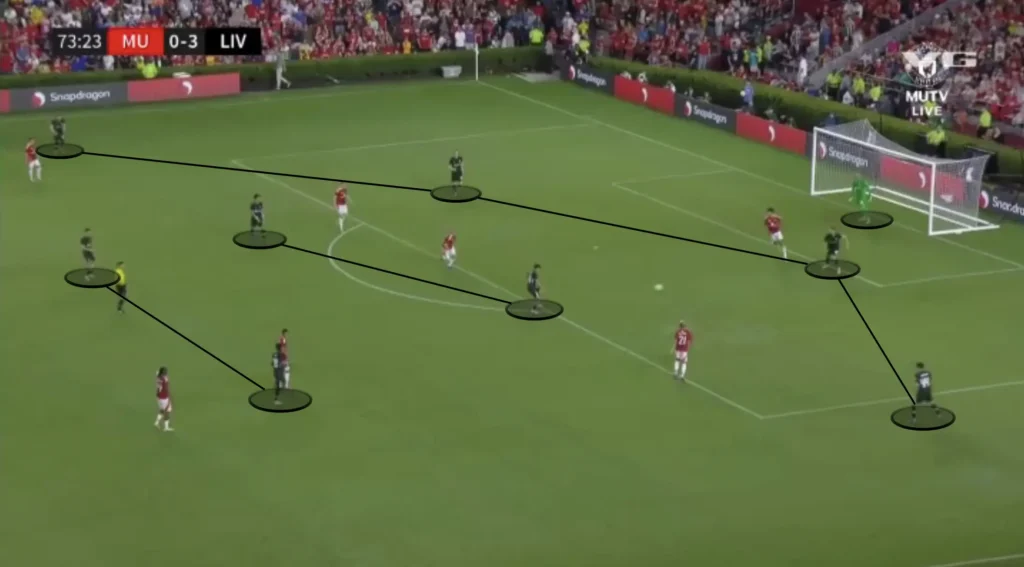
This structure with two dropping strikers and two high wingers, popularized by Roberto De Zerbi, questions the opposition center-backs, forcing them to make difficult decisions. If they push up on the dropping strikers, the space behind them opens up, giving the winger a 1v1 against the fullback in a massive space.
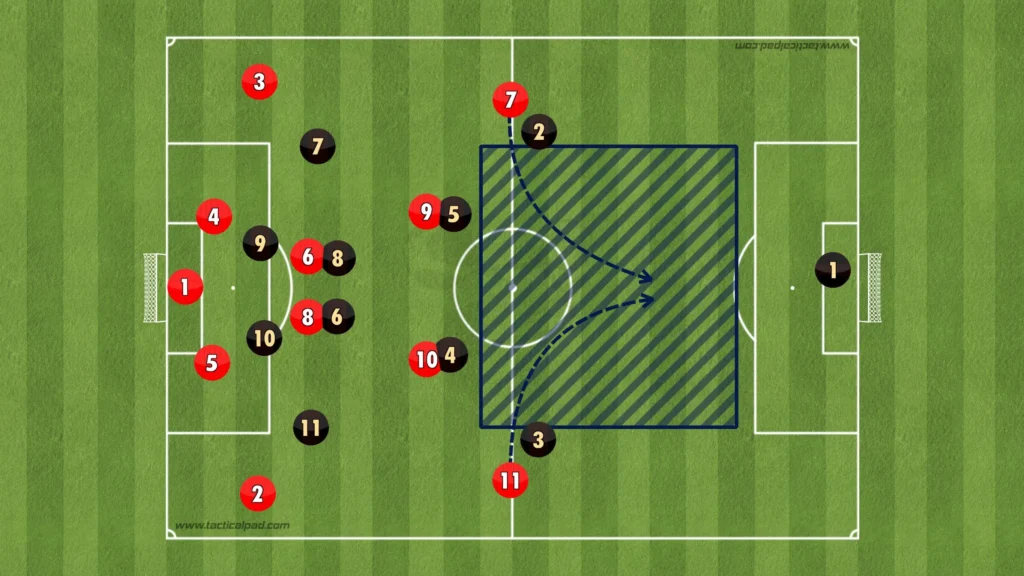
However, if they do not push up on the strikers, a numerical superiority is created in the midfield, allowing Liverpool to play through the press.
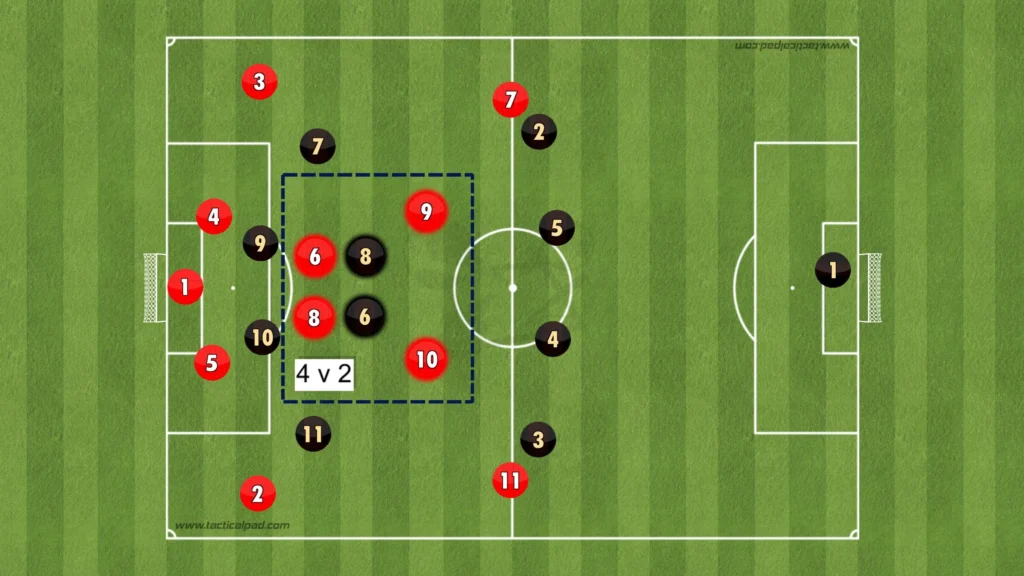
When Liverpool beat the press, the attackers will immediately make runs in behind, looking to exploit the space behind the opposition’s backline.
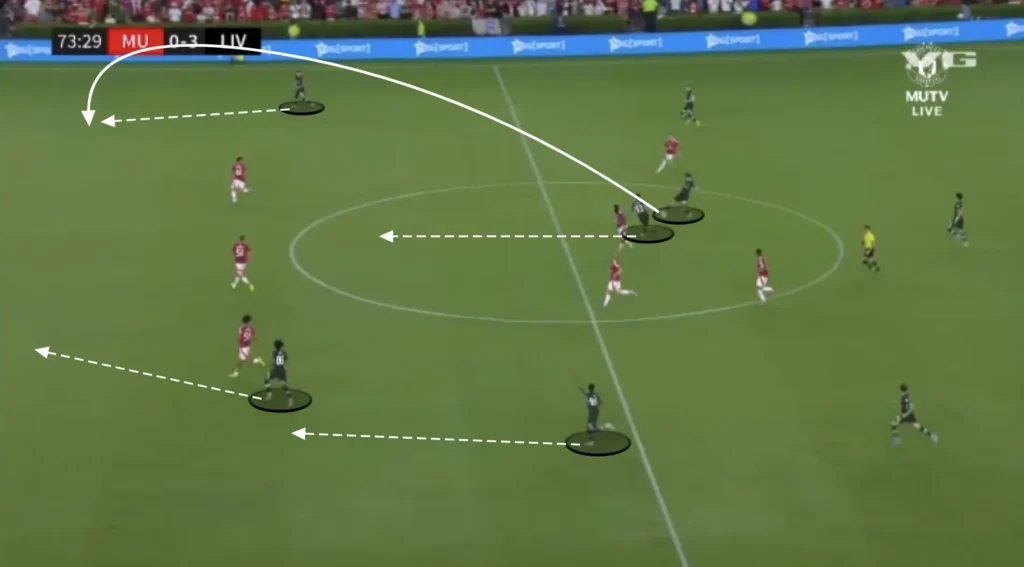
Liverpool are also not afraid to be more direct in their low build-up. If the opposition comes up and presses man-to-man, there will be numerical equality up top with Liverpool’s attackers against the opposition defenders. The goalkeeper will sometimes find an early longer ball up to the attackers, aiming to win 2v2 or 3v3 situations. The Liverpool attackers have good individual quality and will often win these battles to create goalscoring opportunities.
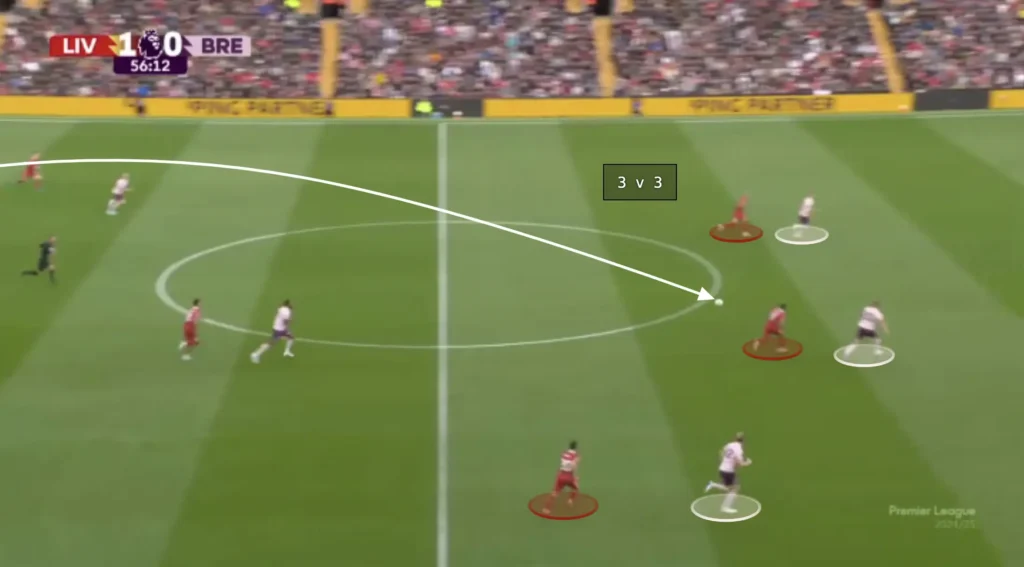
High Build-up
In the high build-up, Liverpool use a dynamic 1-2-4-4 formation, with the fullbacks pushing up next to the holding midfielders.
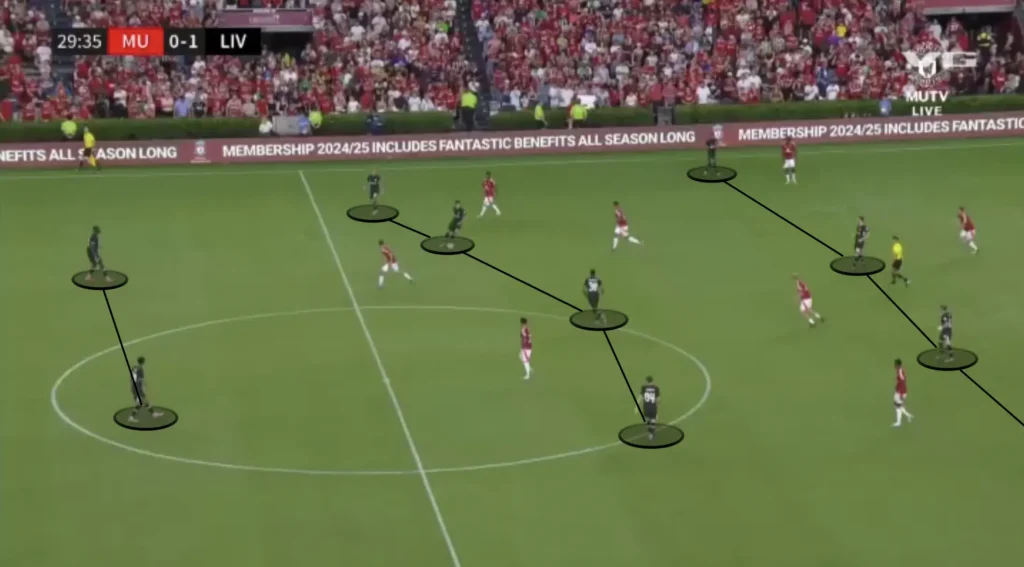
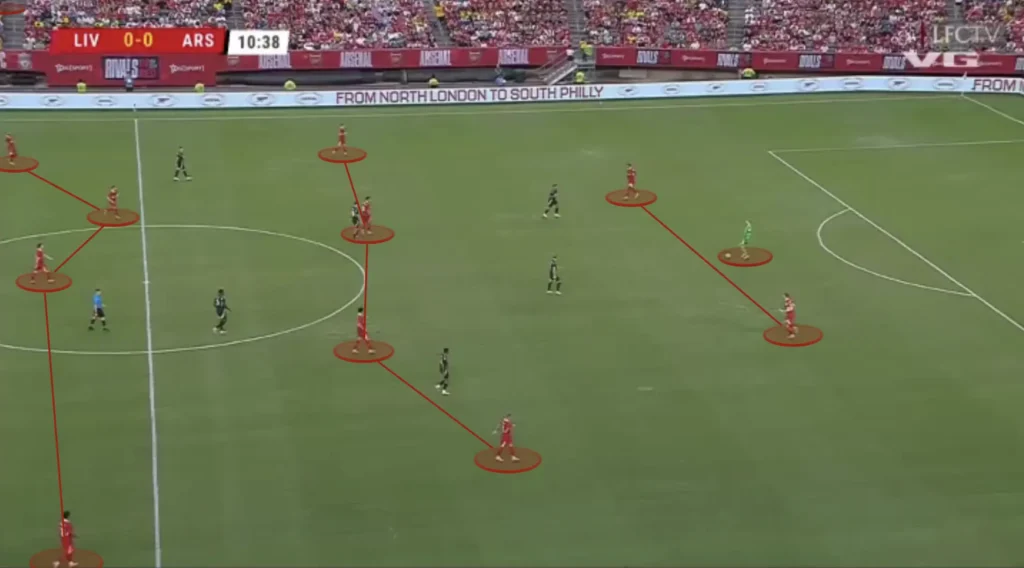
In this attacking system, the fullbacks usually tuck inside into central midfield areas instead of staying wide and hugging the touchline.
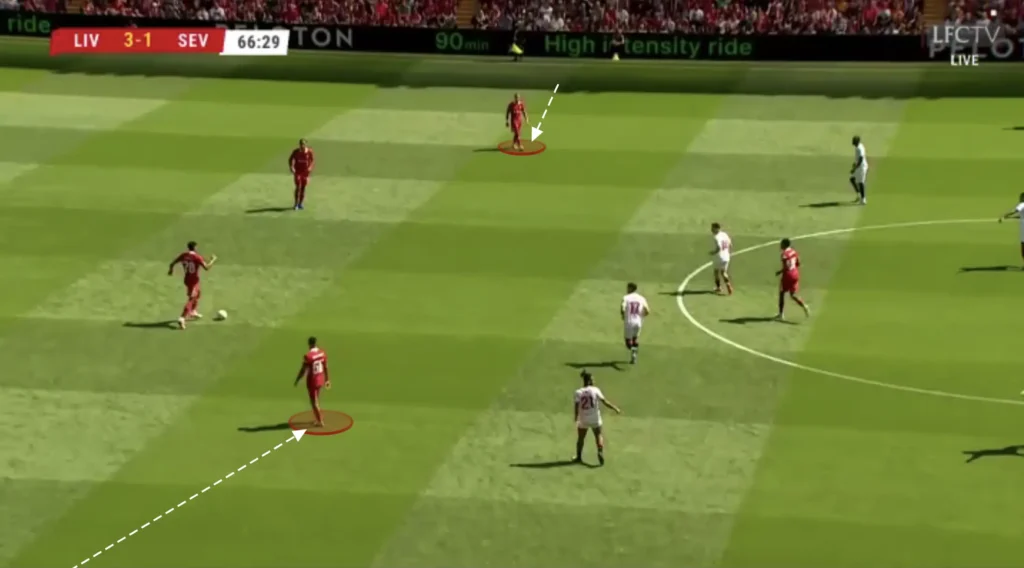
This allows them to contribute to the build-up, create numerical superiority in the middle, and dictate play with their passing range. Alexander-Arnold, for instance, often moves into a deep-lying playmaker role, helping Liverpool control the tempo and progress the ball forward.
The two Liverpool strikers will often drop during the build-up. When the strikers drop, the wingers usually come into the striker’s position, pinning the opposition center-backs, not allowing them to push up on the dropping Liverpool strikers.
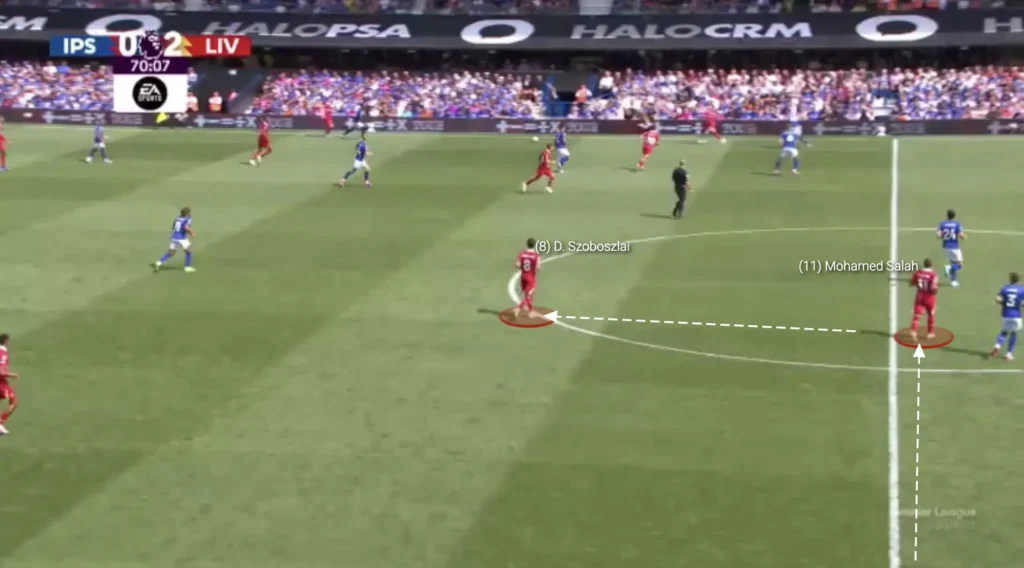
This allows the dropping strikers to receive the ball between the lines, turn, and progress the ball up the pitch.
Fluidity
Liverpool’s fluidity in the build-up under Arne Slot has been a key aspect of their tactical evolution. The team often adopts a dynamic approach, shifting between formations to create numerical advantages and exploit spaces. Slot’s focus is always to get the players into their best positions, where they can make the most out of their individual skills. He emphasizes versatility, with players interchanging positions seamlessly to maintain possession and disrupt the opposition’s defensive structure. Liverpool will, for example, often change the structure to a 1-2-3-2-3/1-2-3-5 formation in the high build-up, committing more players higher up to punish low-defending teams.
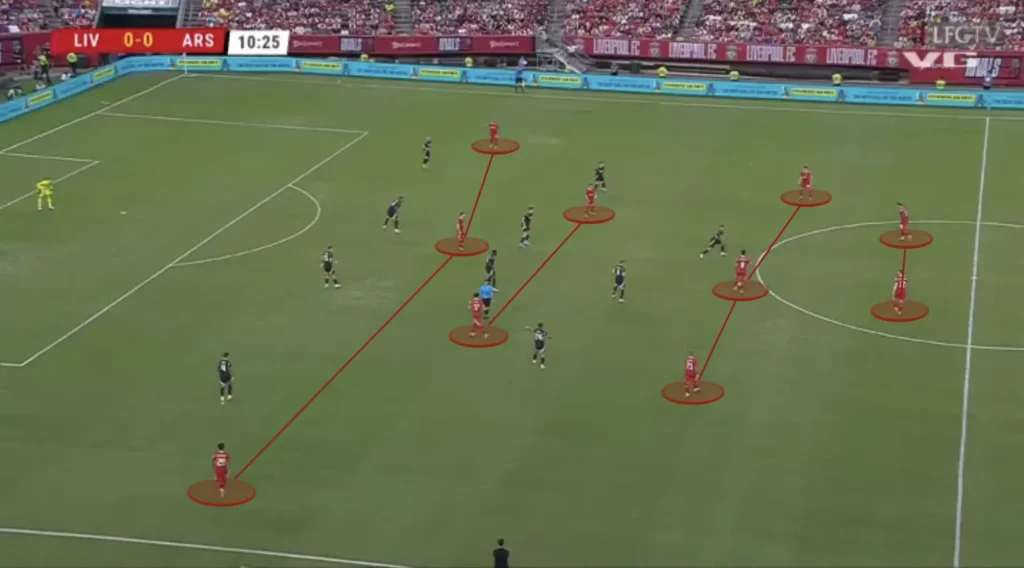
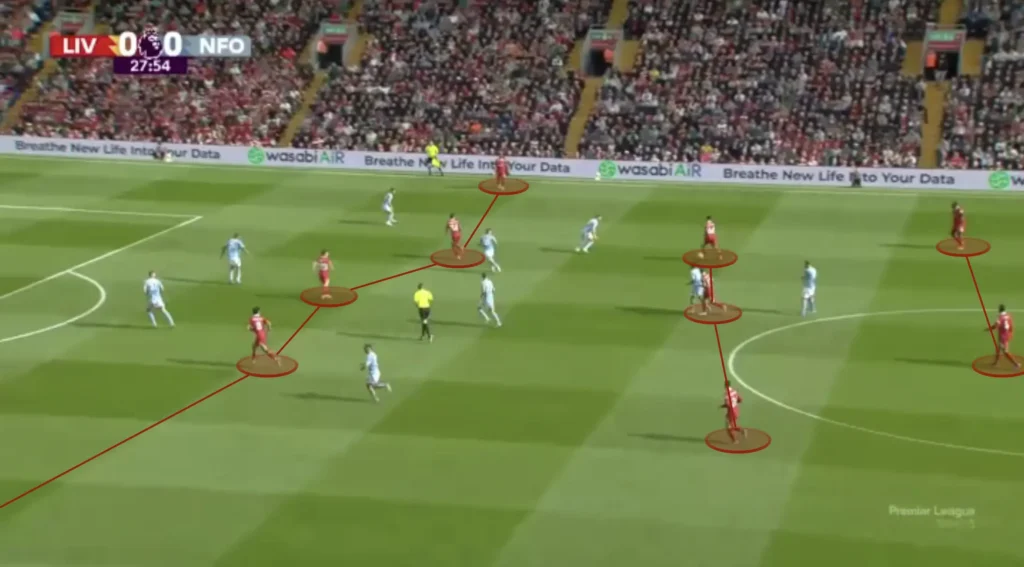
The 1-2-3-2-3/1-2-3-5 formation allows for a strong presence in the midfield, which helps in controlling the game and dictating the tempo. The two central defenders provide a solid foundation for recycling possession, while the three holding midfielders can effectively link play between defense and attack. The five forward players, including wingers and strikers, stretch the opposition’s defense, creating space and overloads in key areas.
While it demands a lot of technical and tactical skills from the players, this fluidity has created new dynamics for Liverpool’s attacking style, offering new solutions and ways of beating the opposition’s press. It enhances their ability to control the game while opening up opportunities for incisive passes and creative plays.
Numerical Advantage in the midfield
Regardless of the formation, Liverpool will have many players in the center. Slot usually has a winger on each side and positions the remaining eight players in the middle. Having only the two wingers out wide and the rest in the middle creates more options in the center and less space between the players. Slot likes this because he prioritizes playing through the middle. He needs one player out wide to pull the opposition apart while the rest create numerical advantages in the midfield areas.
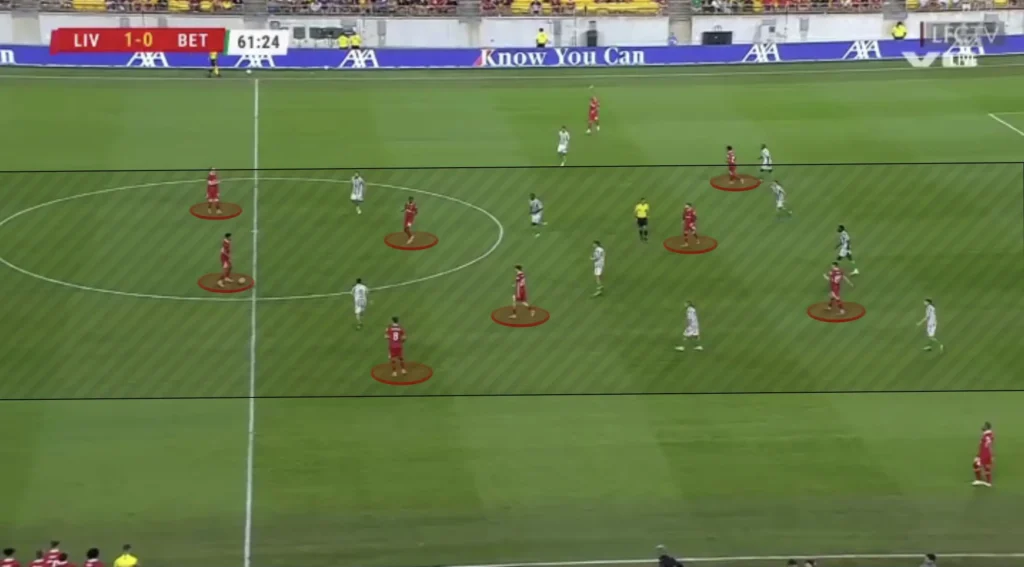
When a team outnumbers the opposition in the midfield, it can more easily retain the ball, exploit spaces, and progress the ball through the center. This advantage forces the opposing team to chase the game, which can lead to defensive errors and create opportunities for breaking down their defense. At the same time, it builds good conditions in defensive transitions since it allows more players to counterpress when they lose the ball.
Another purpose for keeping many players in the middle is to shorten the distance between them. This shortens the length of the passes, which naturally shortens the time between passes. This means the opposition players will have less time to push up and press, giving the Liverpool players more time and control.
Using the Goalkeeper
Arne Slot likes using the goalkeeper in the build-up. Liverpool’s goalkeeper, Alisson, will often push up between the center-backs, giving Liverpool an extra man in the build-up phase.
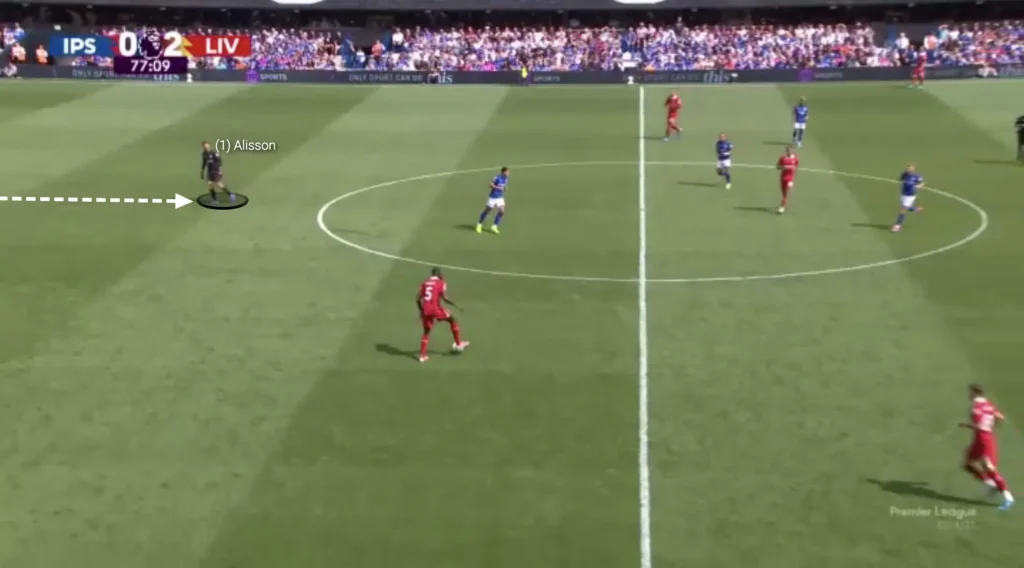
Using the goalkeeper in the build-up phase offers numerous tactical advantages. By involving the goalkeeper, teams can create numerical superiority at the back, making it easier to evade the opponent’s press and maintain possession. This additional player allows for more passing options, reducing the risk of losing possession and enabling smoother transitions from defense to attack. The goalkeeper can also act as a pivot, switching play across the field to exploit weak points in the opposition’s formation. Furthermore, involving the goalkeeper helps in drawing the opposition forward, creating space higher up the pitch for attackers to exploit.
Additionally, with the goalkeeper pushing up, the center-backs can come wider.
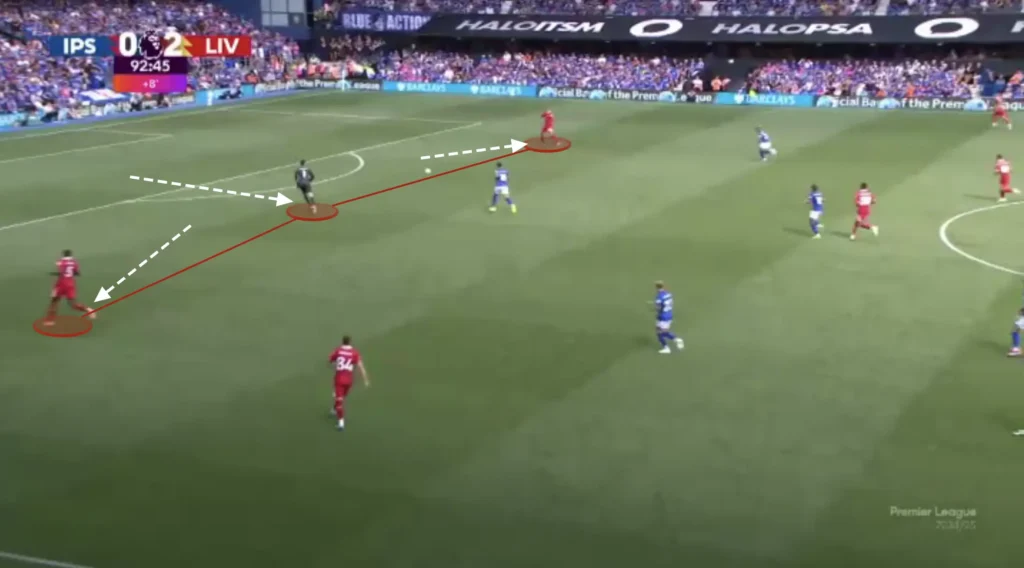
When the center-backs come wider, they can take the ball forward when receiving it to break the opposition’s first line of pressure. This provides a safe and easy way for Liverpool to break the opposition’s first line and progress the ball up the pitch.
Third-man
Arne Slot wants his team to play through the opposition when possible. One vital tool that they often use is the third-man principle. The third-man principle is a tactical concept used to create and exploit space by involving a third player in a passing sequence.
It typically works by having Player A pass the ball to Player B, who then quickly relays it to the free Player C. An opponent will block the pass from Player A to Player C, but the pass from Player B to Player C will be open, which is why he is needed in this passing combination.
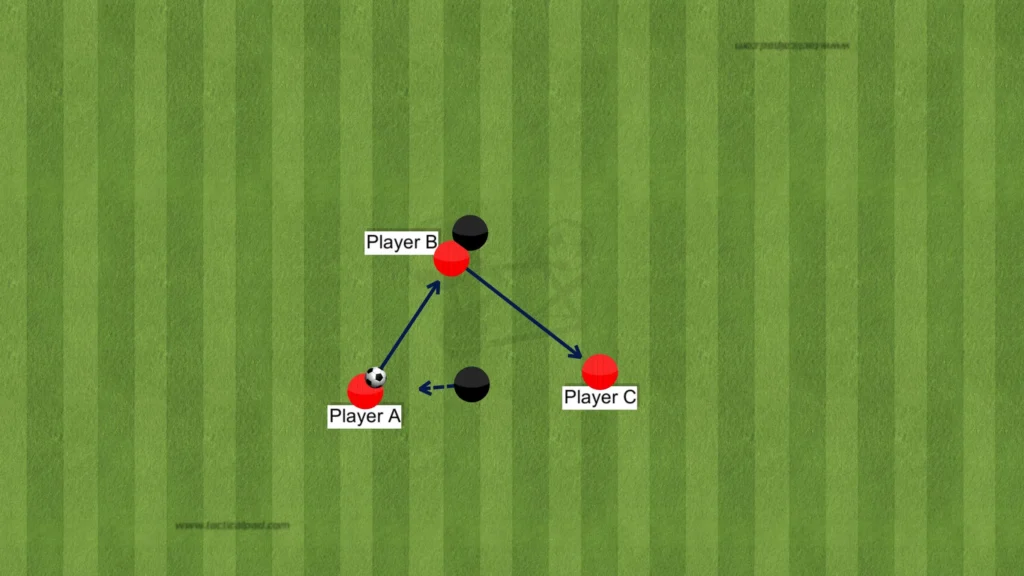
This movement often bypasses an opponent’s pressing line and opens up space, allowing the team to advance the ball more effectively. The key to the third-man principle is timing and positioning, as the third player must anticipate the play, position themselves advantageously, and receive the ball in a manner that breaks the opposition’s defensive structure. This principle is integral to many modern football strategies, promoting fluidity, quick decision-making, and dynamic attacking play.
Liverpool will, for example, use third-man combinations to find an open center-back when the opposition striker presses the goalkeeper.
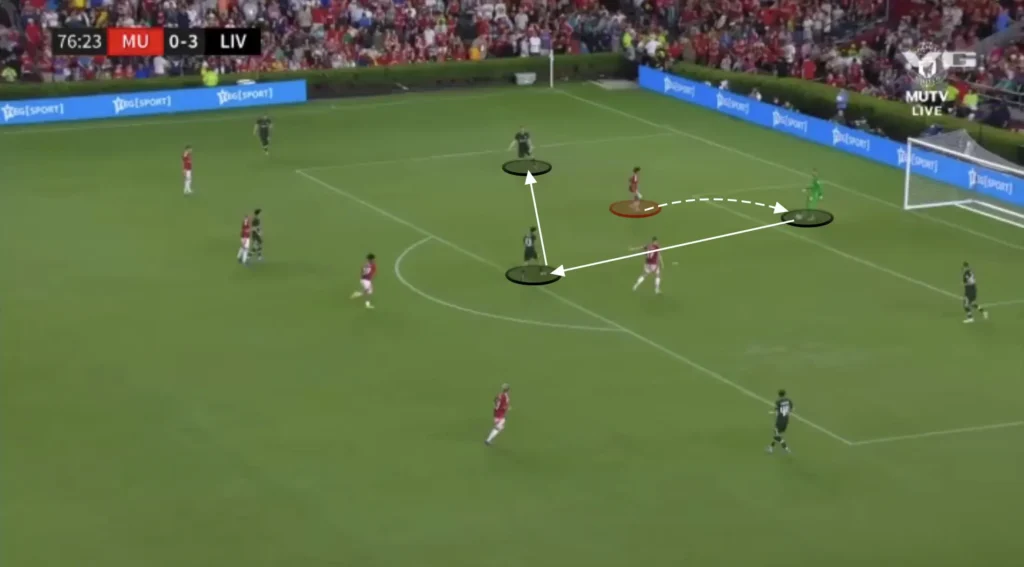
Finding the Pockets
Arne Slot’s players always try to find the strikers in the pockets. These “pockets” refer to the spaces between the opposition’s defensive and midfield lines, where the strikers can drop into and receive the ball in more advanced positions. By positioning themselves intelligently in these pockets, the strikers can turn quickly and face the opposition’s goal, creating opportunities for through balls, driving runs, or direct shots. This positioning forces the opposition to make difficult decisions. If an opposition defender steps up and closes down the dropping striker, he potentially leaves space behind. If he stays back, he allows the striker time on the ball. The Liverpool defenders and holding midfielders will look for straight passes, breaking the opposition lines and finding the strikers who can turn and drive at the defense.
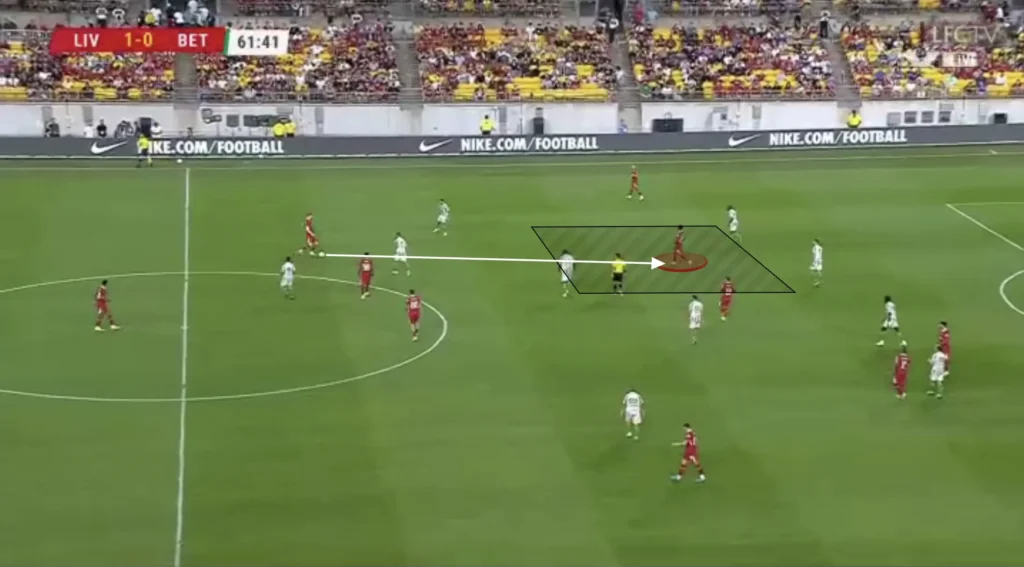
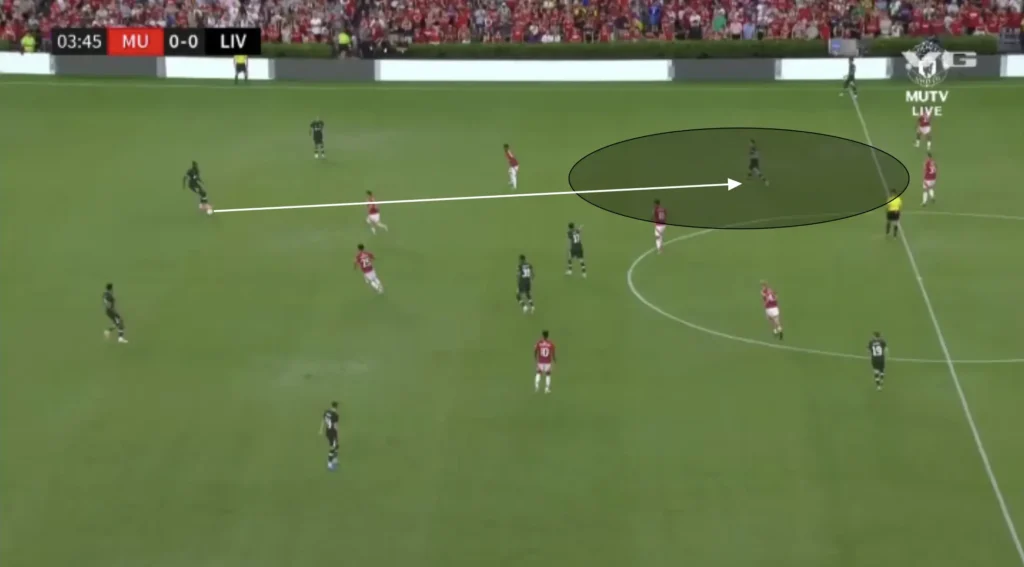
Finding these pockets is crucial for maintaining fluidity in attack and ensuring that the team can progress the ball effectively through the middle of the pitch.
Dropping Outside
When the opposition defends very compactly and does not allow the Liverpool strikers to get the ball in the pockets, Liverpool’s strikers can drop outside to receive the ball there instead. They will wait for the opposition’s wide midfielders to push up and press the fullback, and drop out into the space outside of him. The opposition center-backs and central midfielders rarely follow these runs, not wanting to open the space in the center. Additionally, the winger, who is positioned high up, will be pinning the opposition defenders, not allowing them to jump on the dropping attacking midfielder. This means that the Liverpool striker can receive the ball, turn, and progress the ball unopposed.
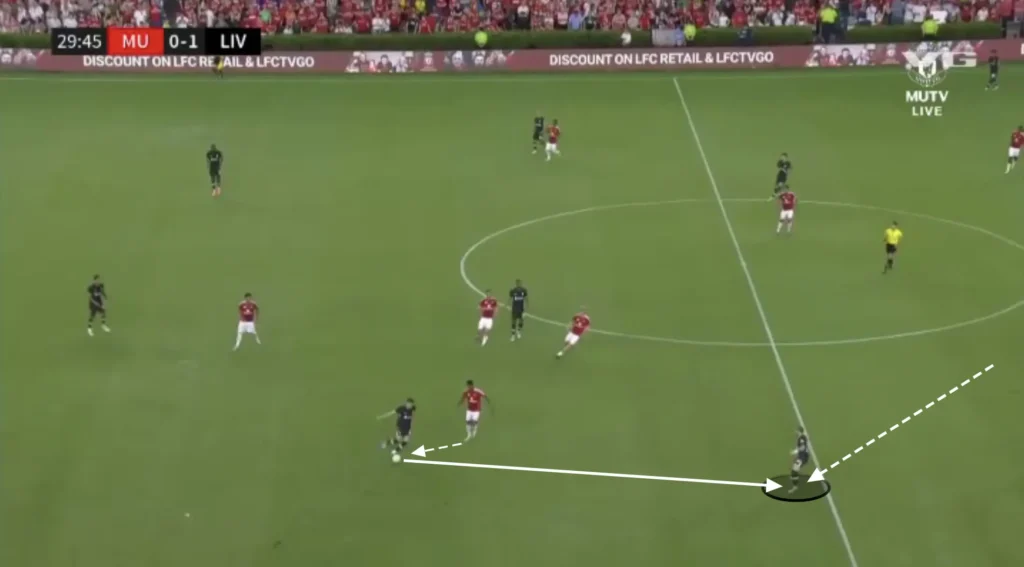
Balls in Behind
Liverpool’s attackers consistently make aggressive runs in behind the opposition defense whenever the central midfielders have the ball. This movement is a key aspect of their offensive strategy, designed to stretch the defensive line and create space. As the midfielders advance, the forwards will run in behind the opposition backline, exploiting gaps between defenders and allowing themselves to receive well-placed through-balls. The coordination between the midfielders and attackers makes Liverpool’s offense unpredictable and difficult to defend against.
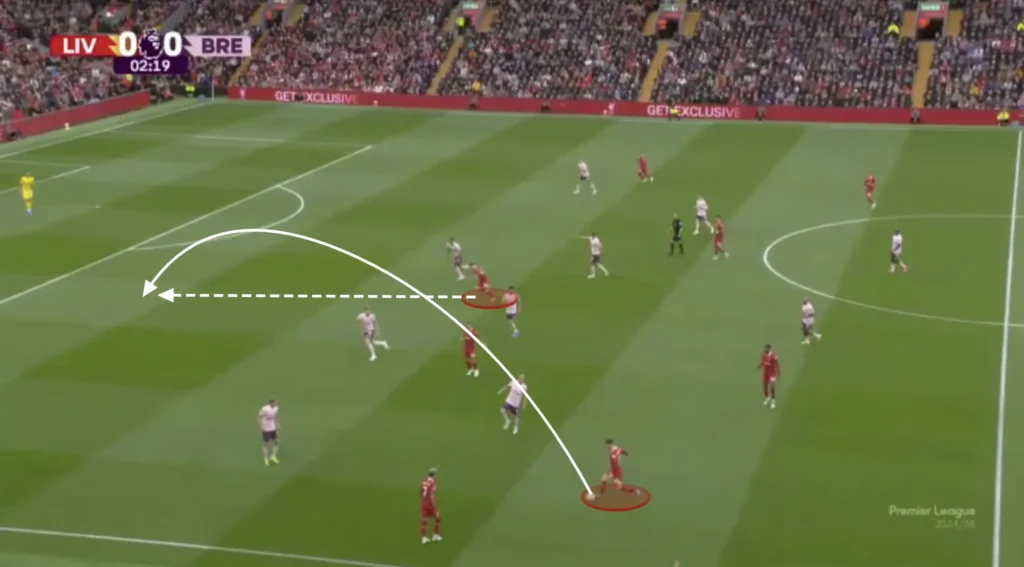
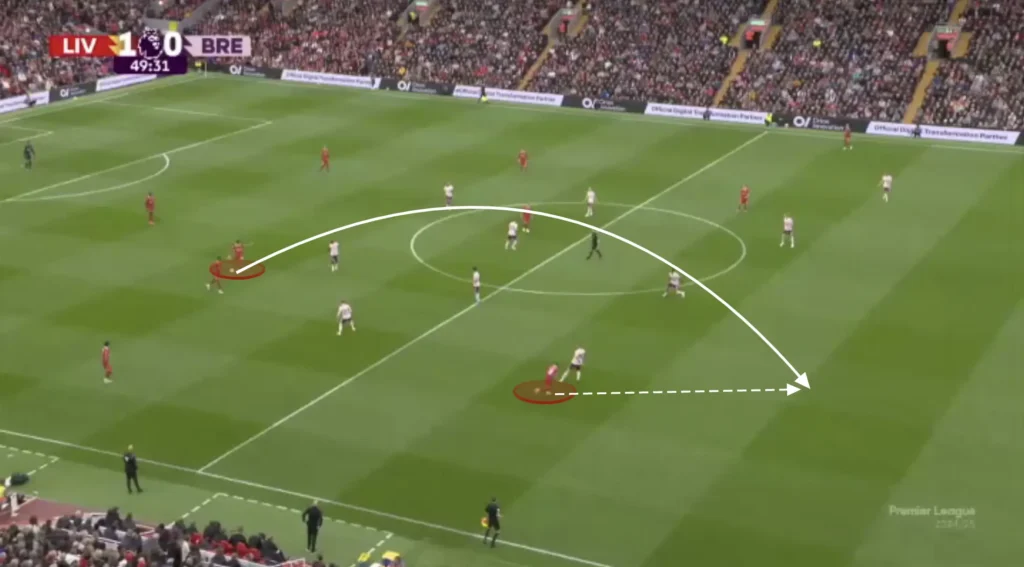
Additionally, this constant threat prevents the opposition from playing with a high backline and closing the space between the lines. Instead, they have to drop the backline and protect the space in behind. This opens the space in front of the backline for the Liverpool midfielders to exploit.
Final Third
Attacking the Half-Space
Arne Slot’s players usually look to create chances by attacking the space between the opposition center-back and fullback. They primarily do this from the wide areas with underlaps from the attackers. When the winger receives the ball out wide he will attract the opposition fullback. This opens the space between the fullback and the center-back, which allows a Liverpool attacker to make the underlapping run into this space. The ball can be played to the underlapping player, who can cross the ball into the box or attack his defender in a 1v1 situation.
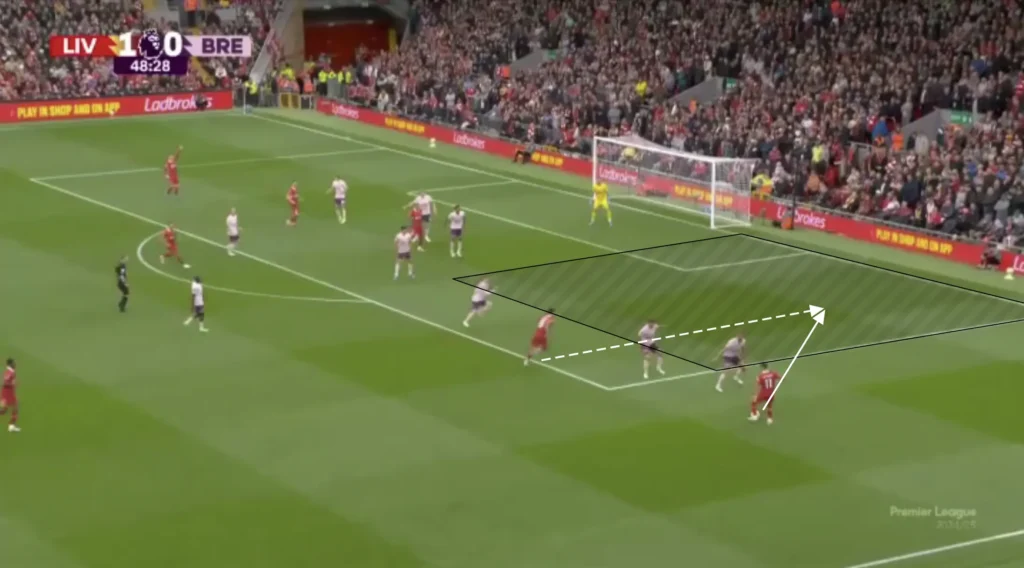
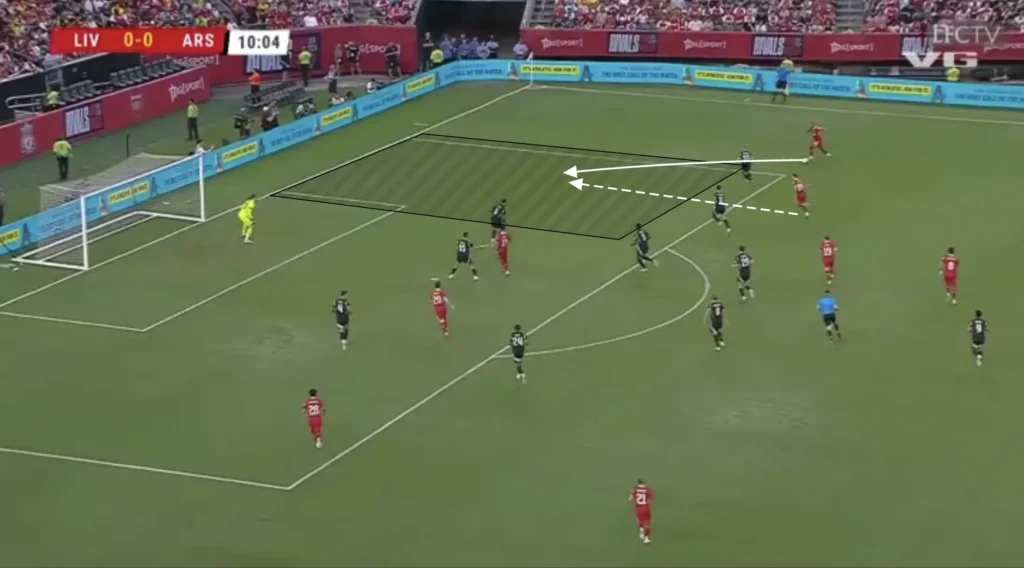
The winger does not have to play the ball to the underlapping player. The run from the Liverpool attacker will often drag away an opposition defensive midfielder, which opens the space inside. The winger can take the ball inside and shoot or find a pass to a free player in front of the backline.
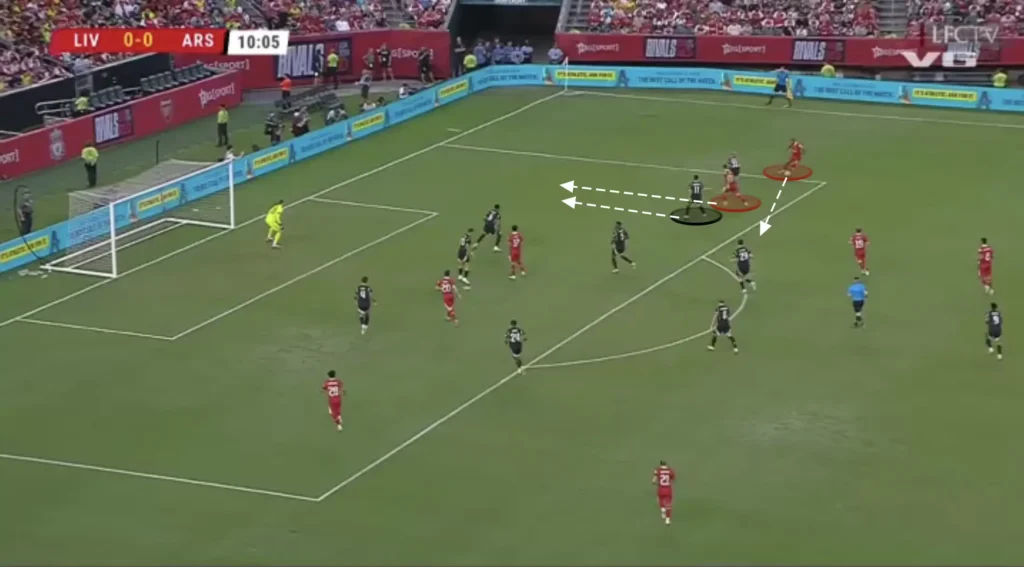
Overlaps
Liverpool will also use overlaps to produce opportunities in the final third. When the winger gets the ball, and the fullback is nearby, the fullback can make the overlapping run, creating a 2v1 against the opposition fullback.
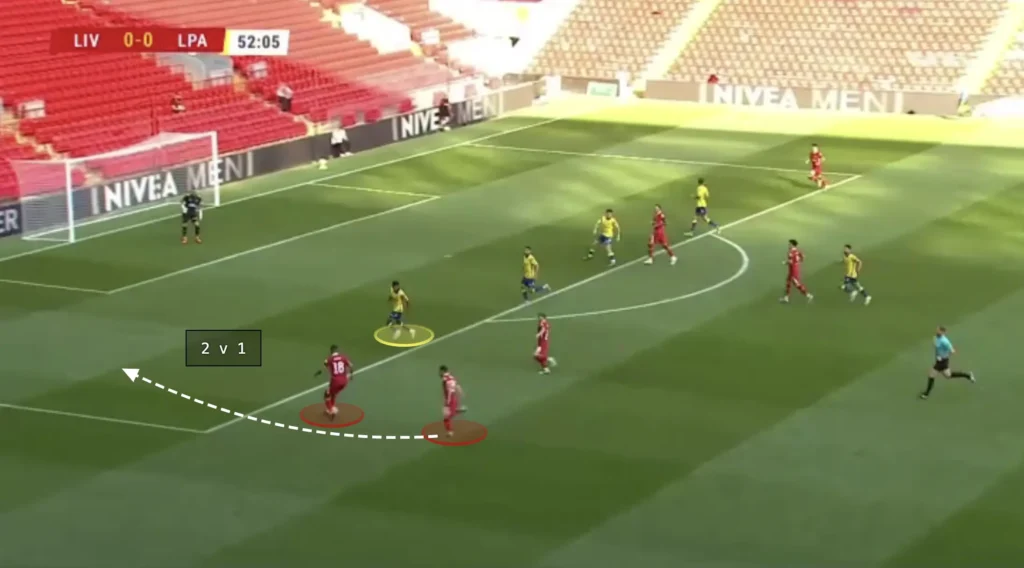
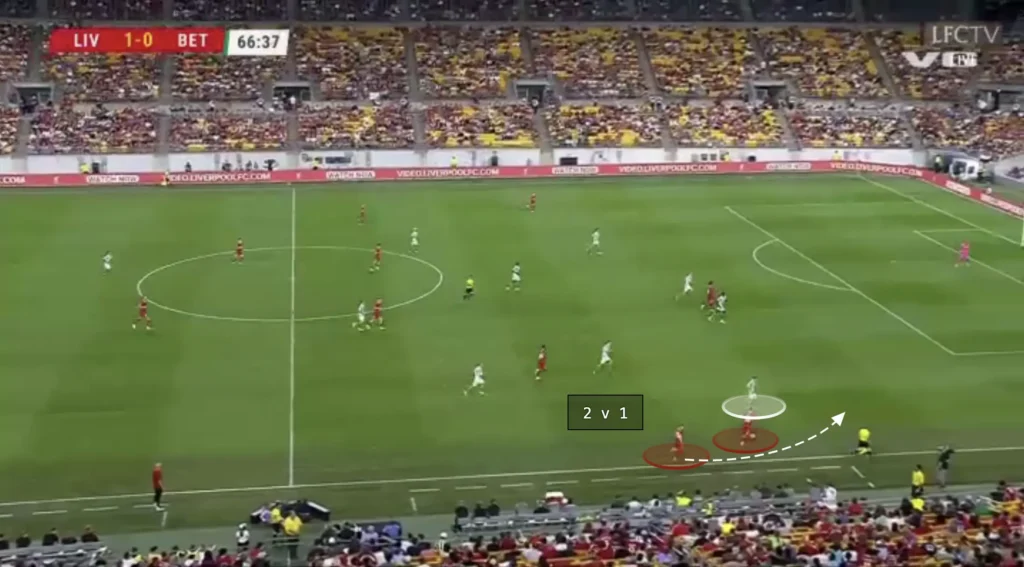
If the opposition fullback drops to cover the overlapping run, the winger could cut inside, taking a shot or combining with a midfielder. If the fullback covers the center, the ball can easily be played to the overlapping player, creating a crossing opportunity.
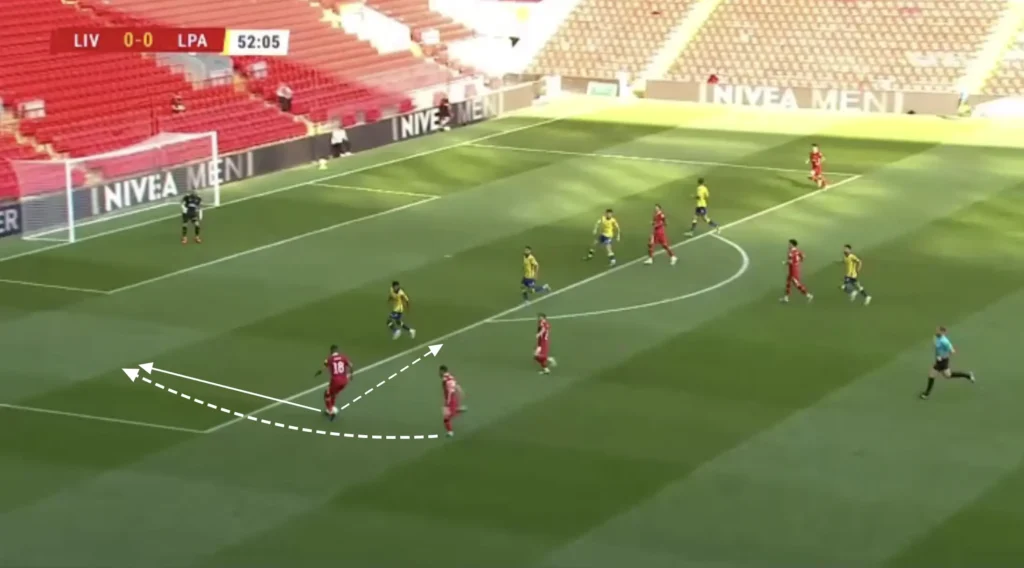
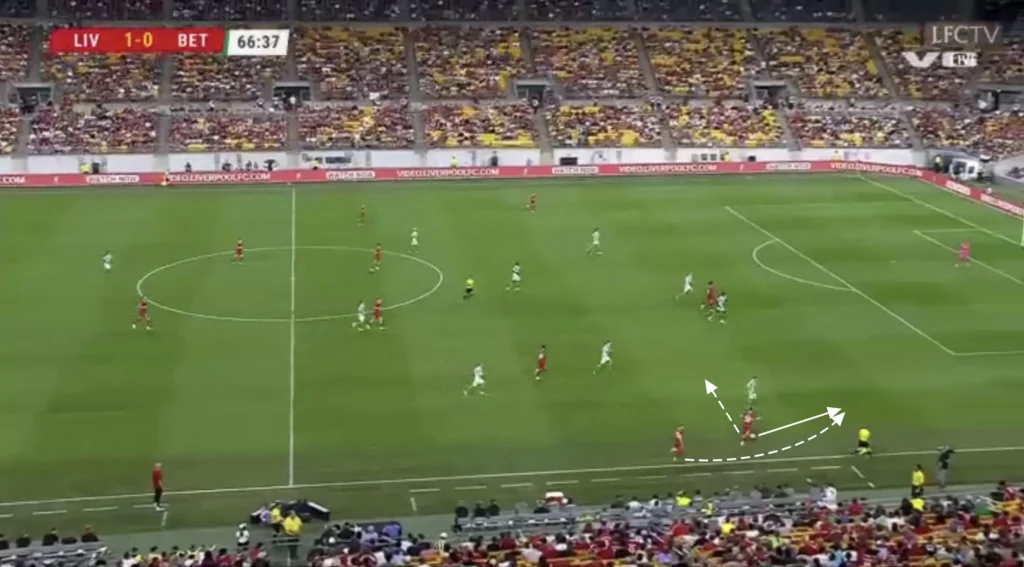
Many Players in the Box
The strikers, midfielders, wingers, and sometimes fullbacks look to make runs into the box when the ball is in the final third, often getting four or five players into these areas to create overloads. The numerical advantages in the box increase the chances of connecting with the cross, as more players present multiple targets for the crosser, making it harder for defenders to mark everyone effectively. Additionally, having multiple players in the box provides options for different types of finishes, whether it’s a header, volley, or a quick tap-in. It also allows for better positioning to react to second balls or rebounds, increasing the likelihood of capitalizing on any defensive errors.
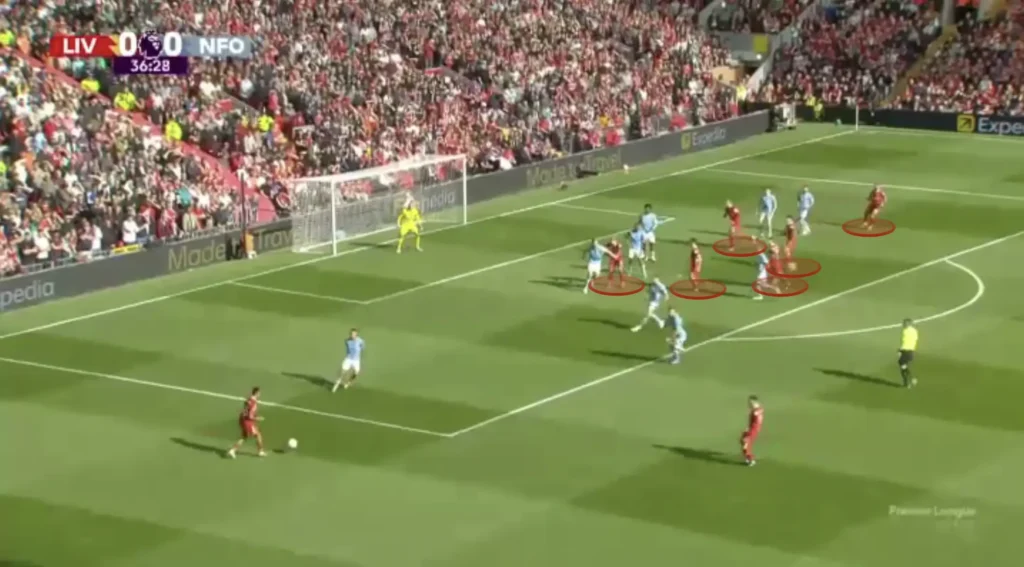
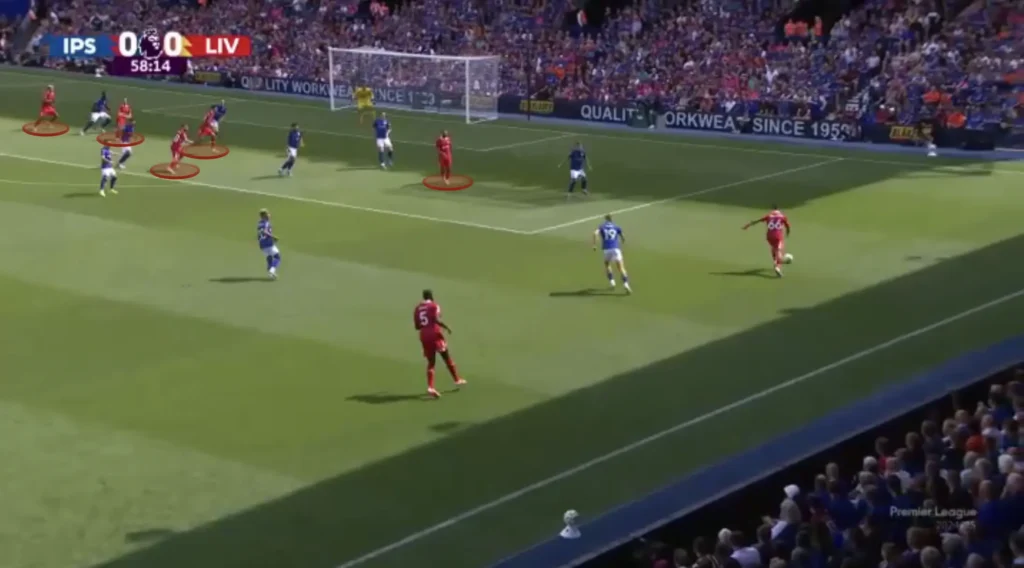
Slot also positions many players outside the box, ready for the second balls and cut-backs. Liverpool will often create crossing opportunities, which pushes down the opposition’s defense and opens the space in front of the opposition’s backline. The holding midfielders can collect any loose balls or be found directly in these spaces with cut-backs, and from there, they can shoot or combine with an attacker to create goalscoring opportunities.
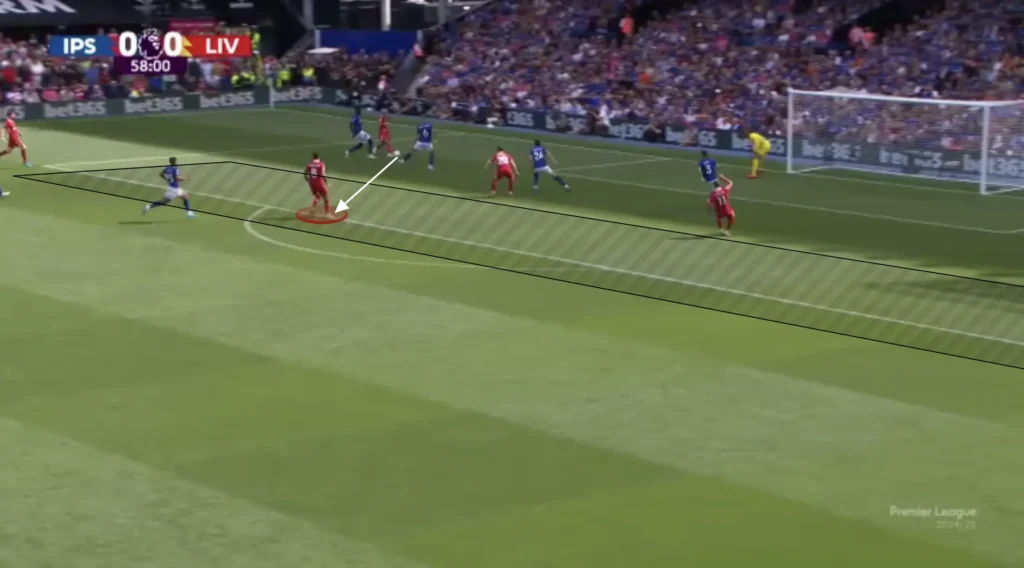
Defending
High Press
Arne Slot usually wants to press the opposition high up the pitch. Their pressing structure will depend on the opposition, but they primarily press in a 1-4-2-3-1 formation.
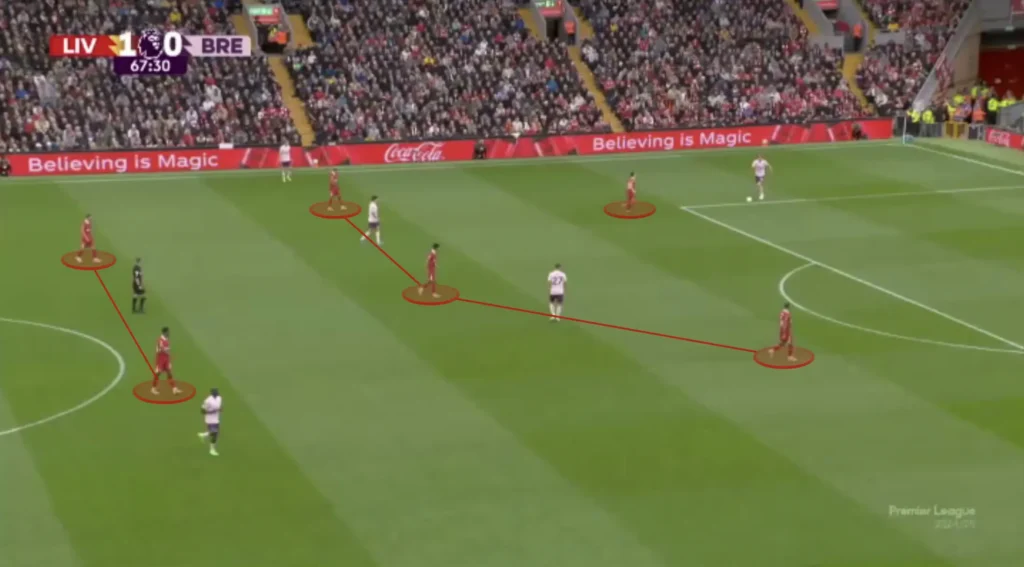
The pressing striker will try to close off one opposition center-back by making angled pressing runs, forcing the opposition to one side. The rest of the players will shift across and try to win the ball by using the touchline as an extra defender.
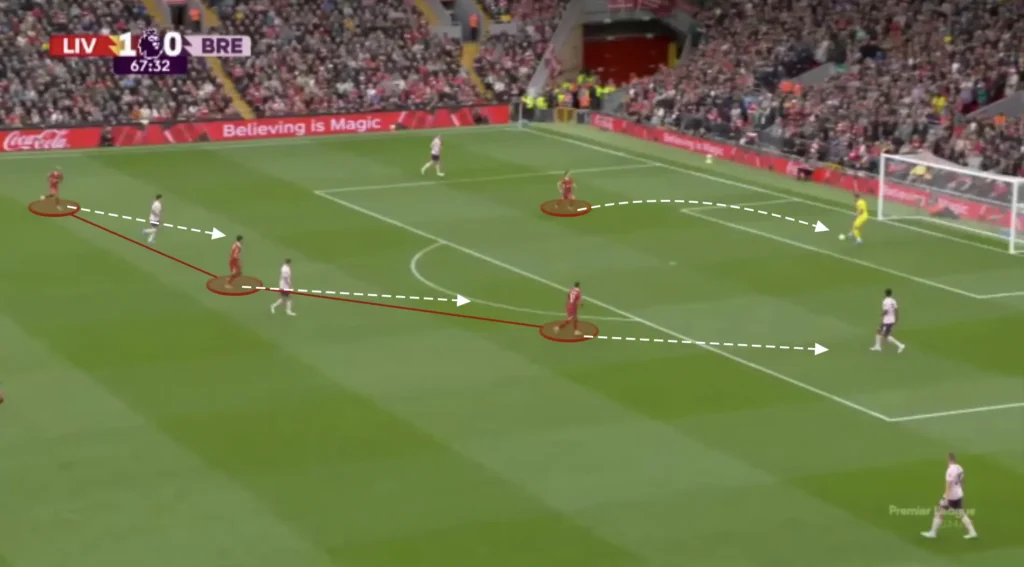
When the opposition gets pushed out to one side, Liverpool will be extremely aggressive and intensely press to win the ball. Every opposition player close to the ball will be marked by a Liverpool player, limiting the options for the ball-carrier, often resulting in a long ball and loss of possession.
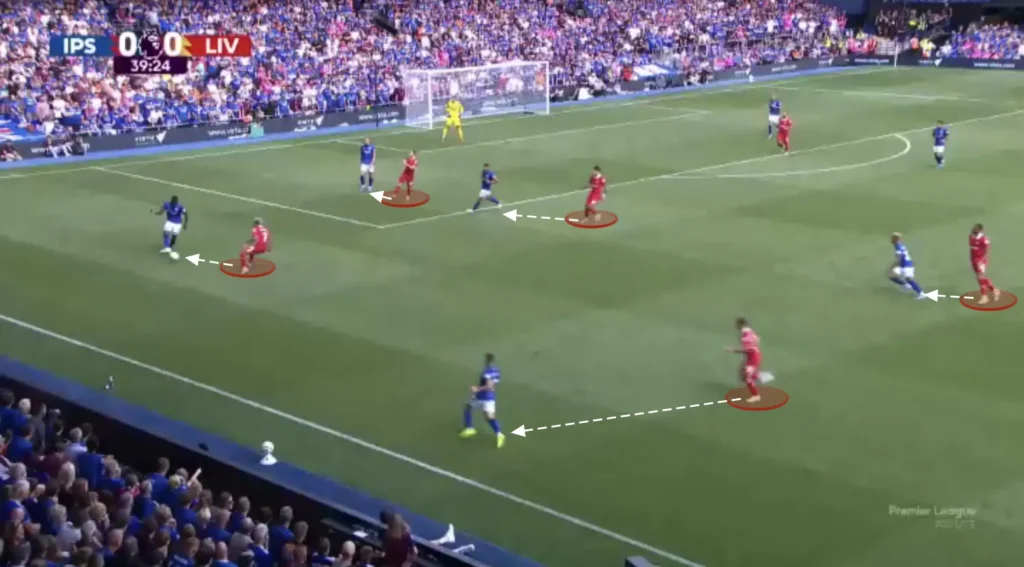
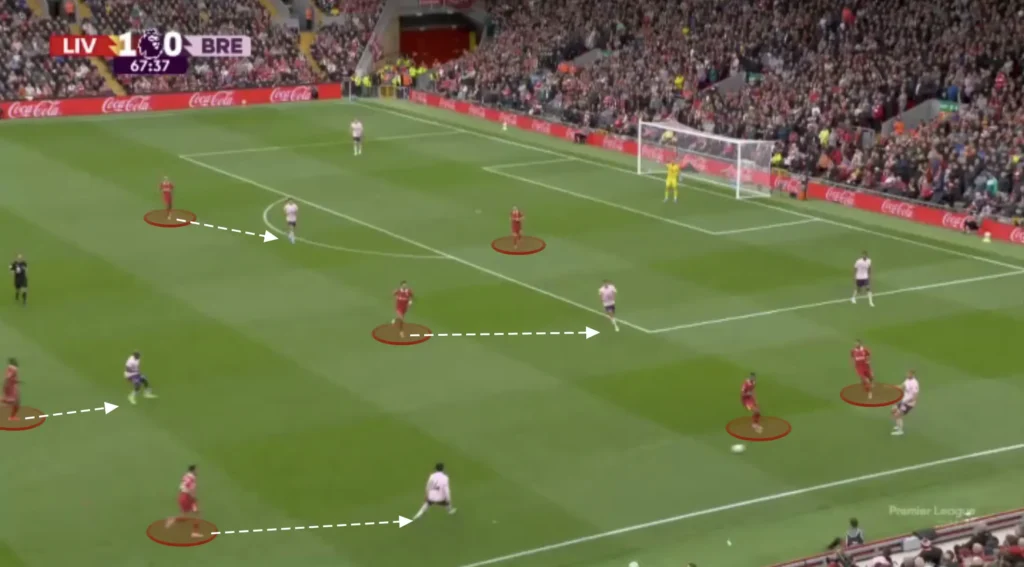
Mid-Block
Liverpool’s base formation when defending is the 1-4-2-4 formation. They look to set up in a mid-block, always trying to close the center and force the opposition out wide. Defending in a 1-4-2-4 formation requires a careful balance between pressing high and maintaining defensive solidity. The two central midfielders play a crucial role, acting as the primary shield in front of the back four, while also supporting the press when the team looks to regain possession. The front four must press aggressively, cutting off passing lanes and forcing the opposition into mistakes. The back four stays compact, with fullbacks responsible for covering wide areas while center-backs maintain a solid shape. Overall, the success of defending in this formation hinges on coordinated pressing, quick transitions, and disciplined positioning to avoid being exposed in central areas.
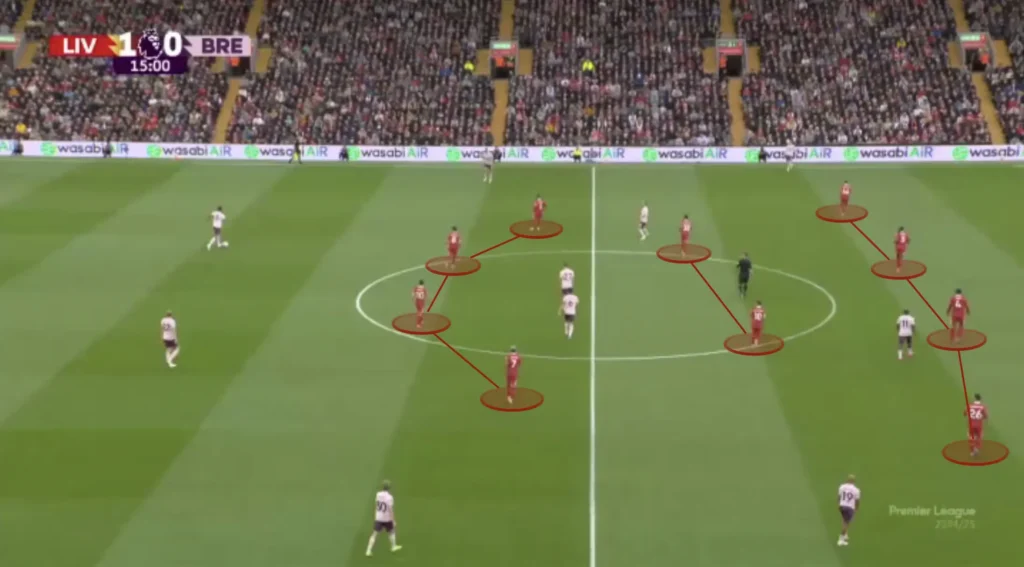
In Liverpool’s 1-4-2-4 formation, the wingers will usually press the opposition center-backs while the two strikers cover the opposition’s holding midfielders.
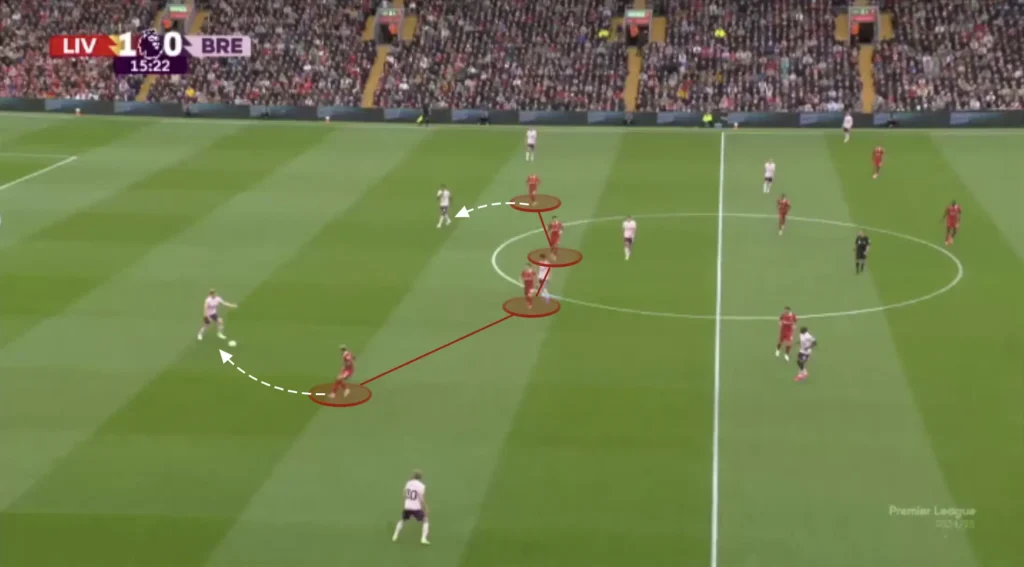
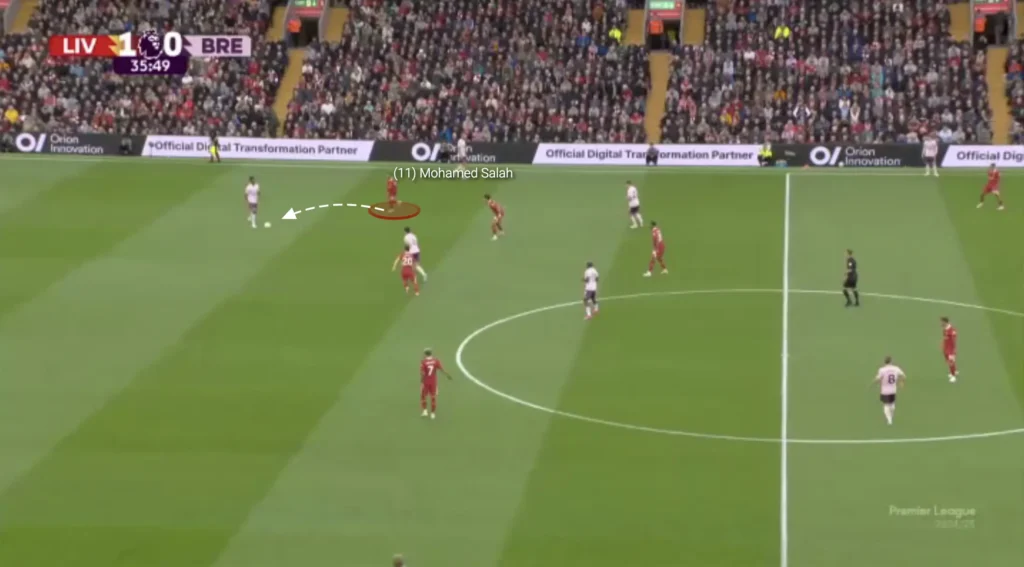
When the wingers press the center-backs, they close the passing lanes to the opposition fullbacks/wingbacks. This forces the opposition center-backs into the middle, where Slot wants to win the ball with the strikers, who block off all passes to the opposition midfielders.
The wide players in the front line also have defensive duties, helping to track back and prevent overloads on the flanks. Suppose the opposition, for example, reaches the fullback through a third-man combination. In that case, Slot primarily wants the winger to track back and press the fullback to stop the opposition from advancing.
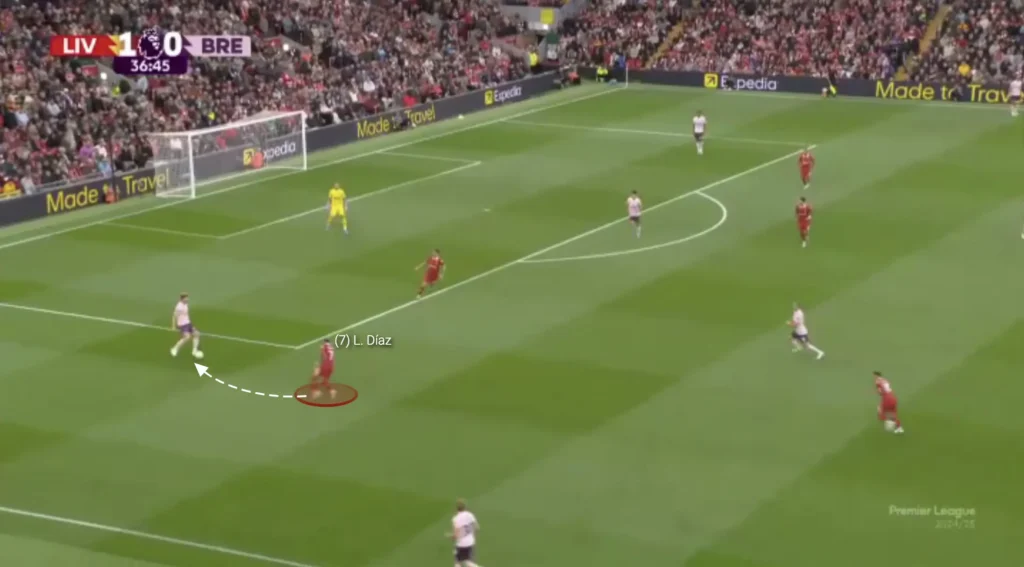
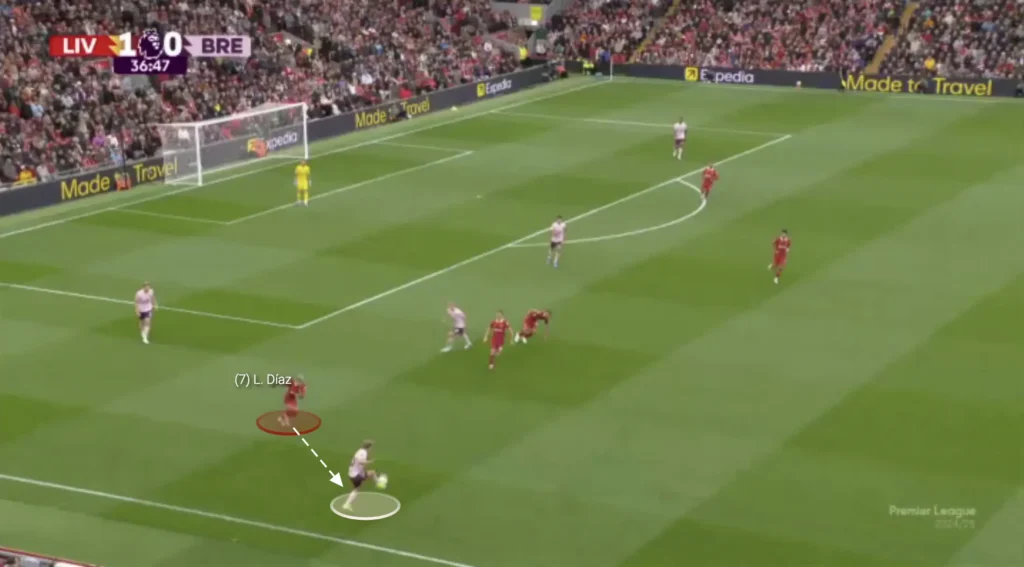
High Backline
One tool that helps to be compact is to play with a high backline, making the space to the midfield line as small as possible. Slot’s players do this and usually try to keep the highest line they can without leaving the space behind them too open. Defending with a high backline involves positioning the defensive line closer to the midfield, rather than near the goalkeeper. This tactic compresses the space available for the opposing team to operate, disrupting their build-up play and increasing the chances of winning the ball back quickly.
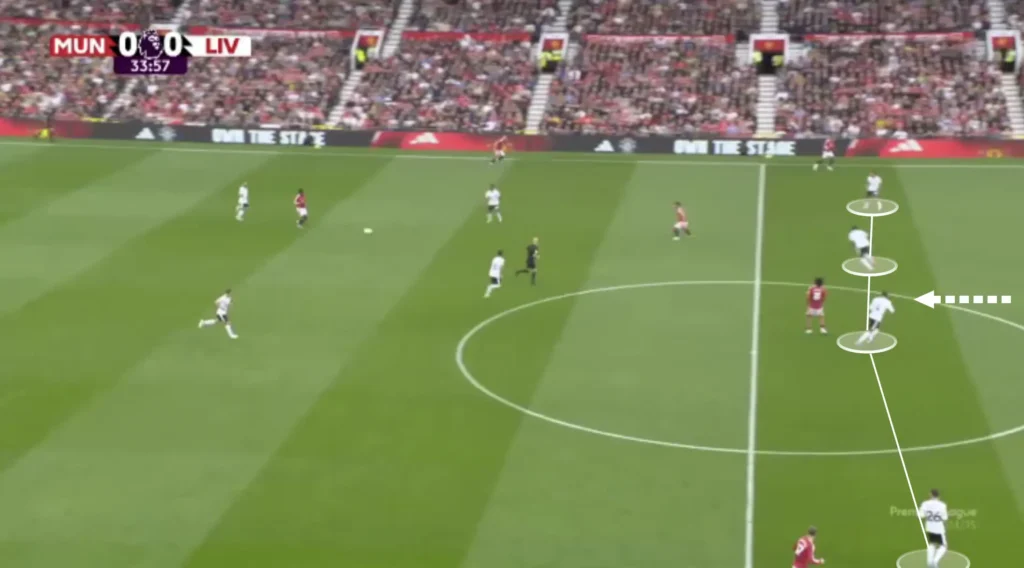
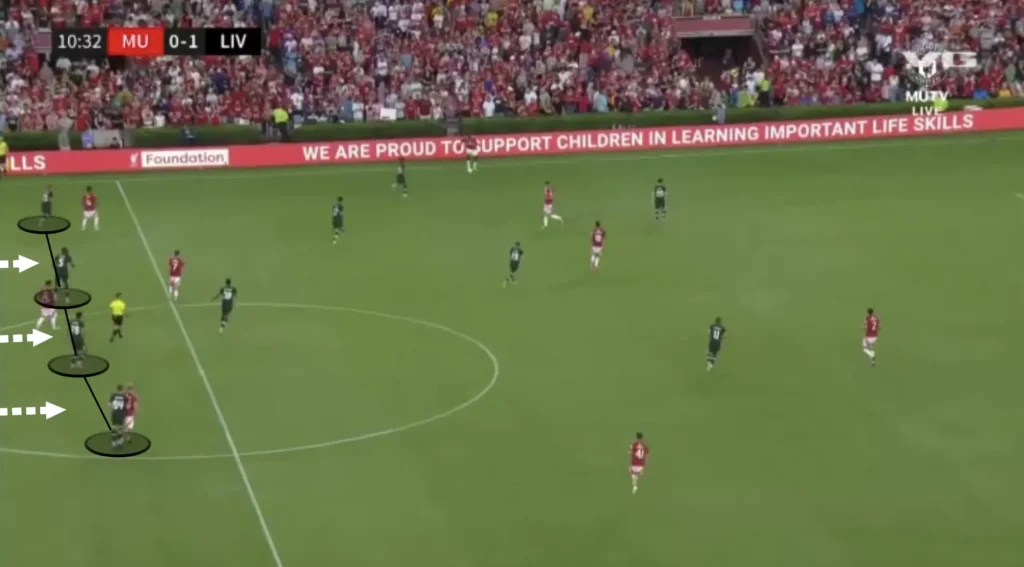
A high backline also allows defenders to support the midfield more effectively, creating numerical superiority in central areas and facilitating quicker transitions from defense to attack. However, it requires defenders with good pace and positional awareness to deal with long balls and prevent opposing attackers from exploiting the space behind. This approach demands constant communication and coordination among the backline to maintain a cohesive and effective defensive structure.
Everyone must be in the same line when defending with a high backline to maintain an effective offside trap, ensure cohesive coverage, and reduce gaps that attackers can exploit. A well-aligned defensive line makes it easier to catch opposing forwards offside, preventing them from receiving the ball in dangerous positions. Additionally, this alignment helps defenders support each other, allowing for quick transitions and coordinated movements to tackle, intercept, and clear the ball.
Transitions
Defensive Transitions
Positioning many players centrally, creating a numerical advantage in the midfield, creates good conditions in defensive transitions. Many players close to the ball after losing possession means that many players can work towards regaining possession. Slot’s players are also very aggressive in the first seconds after losing the ball. The four or five players closest will immediately jump on the opposition player with the ball and close the distance to cut off any passing lanes. This approach disrupts the opponent’s transition from defense to attack, forcing errors and creating opportunities to regain control in dangerous areas.
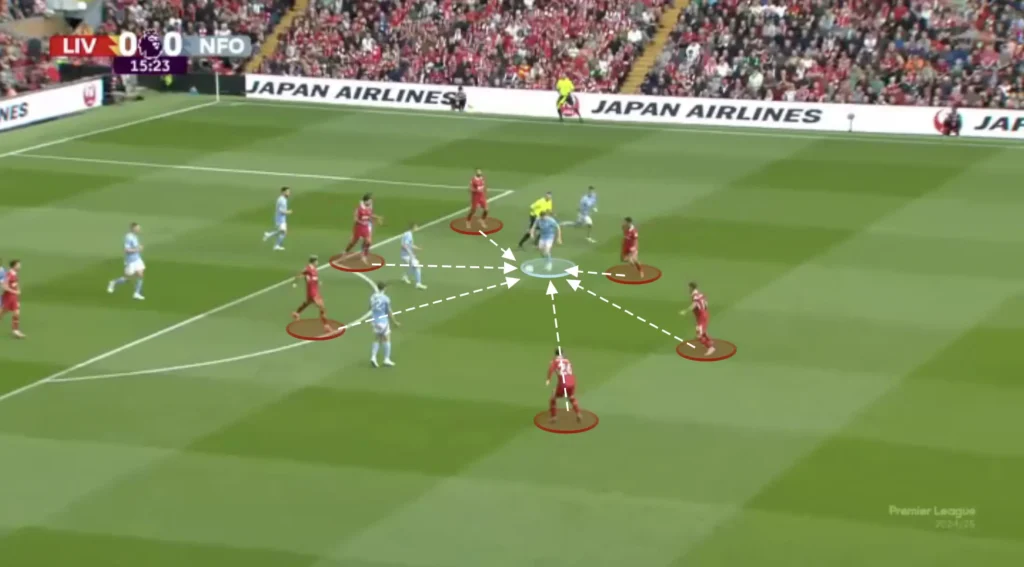
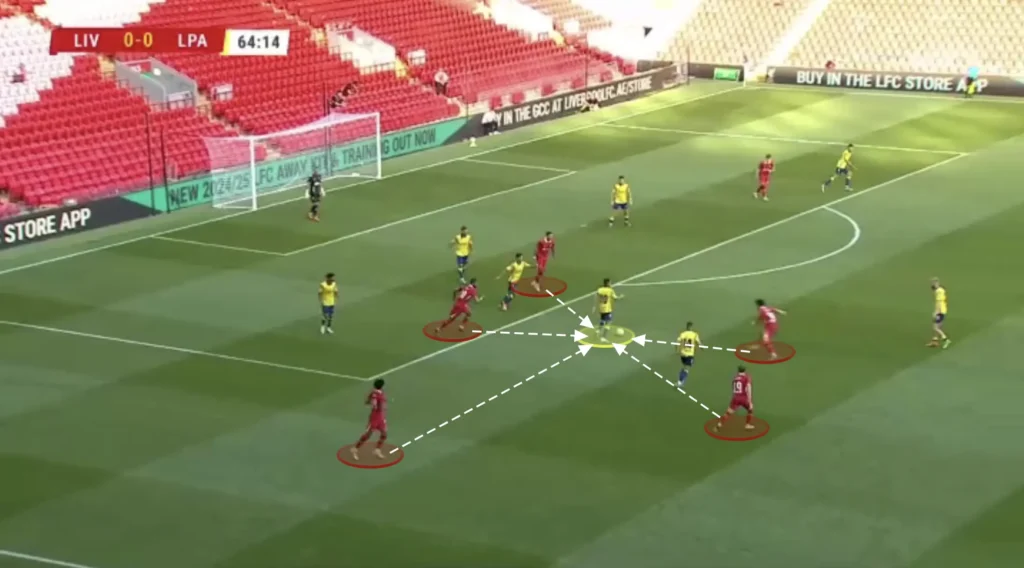
Counterpressing like this keeps Liverpool on the front foot, allowing them to dominate possession and create more scoring opportunities. However, it requires exceptional fitness, tactical discipline, and teamwork.
Offensive Transitions
Arne Slot also wants his team to counterattack in their offensive transitions. When winning the ball back, the team transitions quickly from defense to attack, utilizing the speed and movement of their forward players. Slot emphasizes vertical passes to exploit spaces left by the opposition, often targeting wide areas or gaps between defenders. Liverpool’s counterattacks are well-organized, with players making intelligent off-the-ball runs to create overloads and support the ball carrier. This quick, direct style catches opponents off guard, making Liverpool a dangerous team on the break. Additionally, Liverpool’s aggressiveness means they have many players high up when defending, which enables them to incorporate more players into the counterattacks.
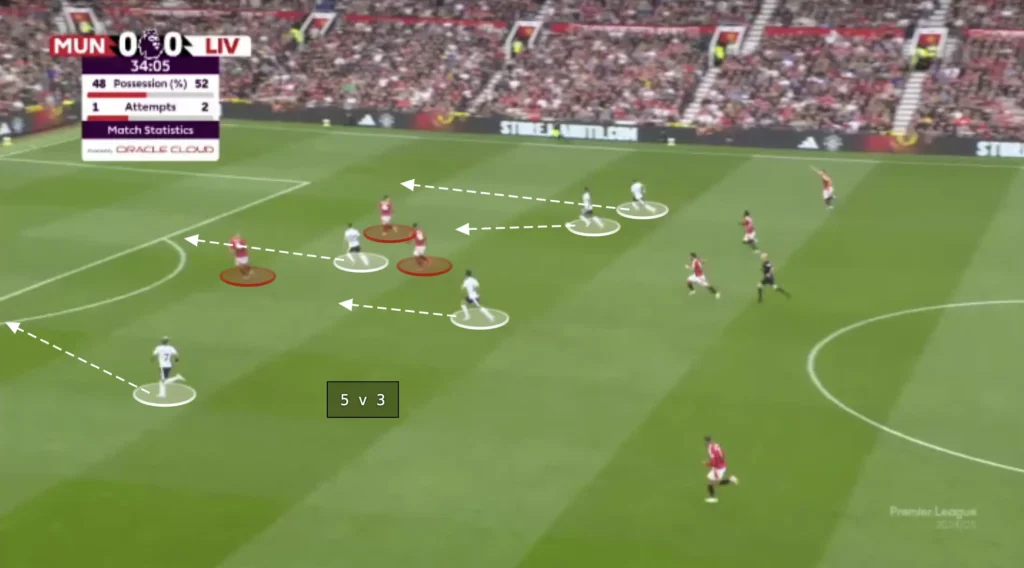
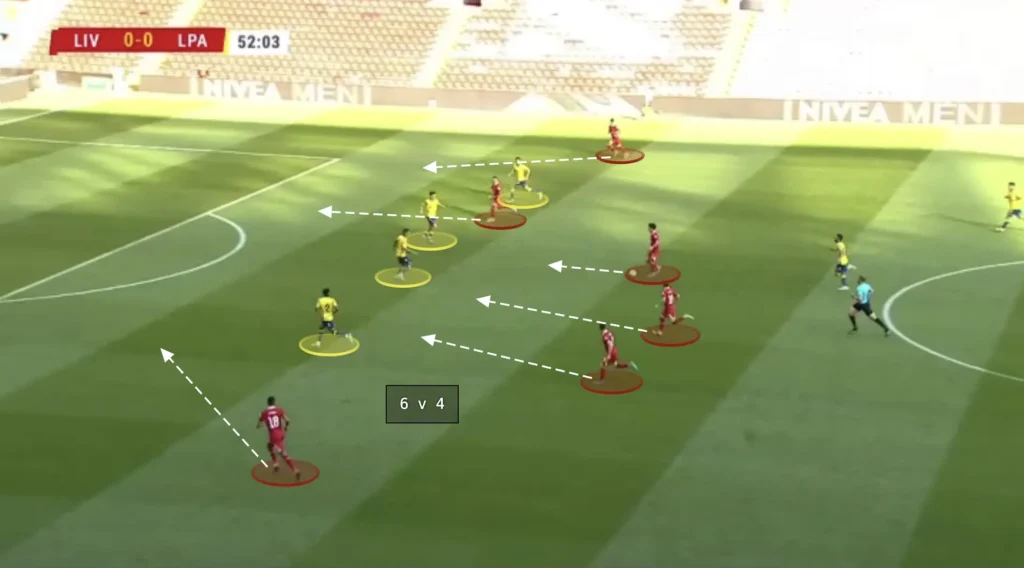
Final Thoughts
In conclusion, Arne Slot’s tactical approach against Liverpool highlighted his ability to adapt and compete with one of Europe’s elite teams. His emphasis on high pressing, quick transitions, and positional play demonstrated a clear game plan designed to exploit Liverpool’s vulnerabilities. Though Slot’s side faced challenges, particularly in dealing with Liverpool’s intensity and pace, the tactical adjustments and disciplined structure showed Slot’s tactical acumen.
This analysis of Arne Slot’s strategy reveals his forward-thinking approach to modern football. As his managerial career progresses, Slot’s tactical philosophy will continue to evolve, making him a coach to watch on the European stage.
